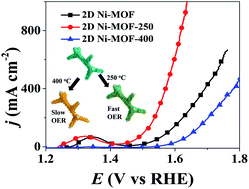当前位置:
X-MOL 学术
›
J. Mater. Chem. A
›
论文详情
Our official English website, www.x-mol.net, welcomes your
feedback! (Note: you will need to create a separate account there.)
Unconventionally fabricating defect-rich NiO nanoparticles within ultrathin metal–organic framework nanosheets to enable high-output oxygen evolution†
Journal of Materials Chemistry A ( IF 10.7 ) Pub Date : 2019-12-28 , DOI: 10.1039/c9ta12713e Qi Hu 1, 2, 3, 4 , Xiaowan Huang 1, 2, 3, 4 , Ziyu Wang 1, 2, 3, 4 , Guomin Li 1, 2, 3, 4 , Zhen Han 1, 2, 3, 4 , Hengpan Yang 1, 2, 3, 4 , Xiangzhong Ren 1, 2, 3, 4 , Qianling Zhang 1, 2, 3, 4 , Jianhong Liu 1, 2, 3, 4 , Chuanxin He 1, 2, 3, 4
Journal of Materials Chemistry A ( IF 10.7 ) Pub Date : 2019-12-28 , DOI: 10.1039/c9ta12713e Qi Hu 1, 2, 3, 4 , Xiaowan Huang 1, 2, 3, 4 , Ziyu Wang 1, 2, 3, 4 , Guomin Li 1, 2, 3, 4 , Zhen Han 1, 2, 3, 4 , Hengpan Yang 1, 2, 3, 4 , Xiangzhong Ren 1, 2, 3, 4 , Qianling Zhang 1, 2, 3, 4 , Jianhong Liu 1, 2, 3, 4 , Chuanxin He 1, 2, 3, 4
Affiliation

|
The high-temperature calcination of metal–organic frameworks (MOFs) often leads to a sharp collapse in the abundant pores inside the MOFs and a serious aggregation of metal sites, which are adverse to electrocatalysis performance. Here, a controllable calcination route was developed for the partial decomposition of ultrathin 2D Ni-based MOF (2D Ni-MOF) precursors to fabricate ultrafine NiO nanoparticles (NPs) within the ultrathin 2D Ni-MOF. In particular, 2D Ni-MOF precursors (thickness: ∼2 nm), for the first time, were rapidly synthesized via a microwave-assisted solvothermal method. The controllable calcination route effectively retained the ultrathin 2D porous nanostructure of the MOFs, and simultaneously enabled the formation of defect-rich ultrafine NiO NPs within the 2D Ni-MOF. Benefiting from the unique nanostructure (i.e., ultrathin 2D nanosheets) and highly active sites (i.e., defect-rich NiO NPs), the partially decomposed 2D Ni-MOF-250 exhibited excellent performance for oxygen evolution reaction (OER) with an overpotential of 250 mV at 50 mA cm−2 in 1 M KOH, outperforming those obtained from other reported nonprecious-metal-based electrocatalysts. More importantly, 2D Ni-MOF-250 could achieve the industry-related current density of 1000 mA cm−2 at a small overpotential of 410 mV, demonstrating its promising potential for use in practical applications. Therefore, the controllable calcination route may stand out as a facile yet robust route for smartly fabricating defect-rich metal oxides within MOFs toward efficient electrocatalysis.
中文翻译:

在超薄金属-有机骨架纳米片中非常规地制造富含缺陷的NiO纳米颗粒,以实现高产量的氧气释放†
金属有机骨架(MOF)的高温煅烧通常会导致MOF内部大量孔洞急剧塌陷以及金属部位严重聚集,这不利于电催化性能。在这里,开发了一种可控的煅烧路线,用于超薄2D Ni基MOF(2D Ni-MOF)前体的部分分解,以在超薄2D Ni-MOF中制造超细NiO纳米颗粒(NPs)。特别是,首次通过以下方法快速合成了二维Ni-MOF前体(厚度:〜2 nm)。微波辅助溶剂热法。可控的煅烧途径有效地保留了MOF的超薄二维多孔纳米结构,同时能够在二维Ni-MOF中形成富含缺陷的超细NiO NP。得益于独特的纳米结构(即超薄2D纳米片)和高活性位点(即富含缺陷的NiO NP),部分分解的2D Ni-MOF-250对氧释放反应(OER)表现出优异的性能,超电势为250在1 M KOH中在50 mA cm -2下的mV优于从其他报道的基于非贵金属的电催化剂获得的mV。更重要的是,二维Ni-MOF-250可以实现与行业相关的1000 mA cm -2的电流密度410mV的小过电位,证明了其在实际应用中很有希望的潜力。因此,可控制的煅烧路线可能是在MOF中智能制造富含缺陷的金属氧化物以进行有效电催化的便捷而稳健的路线。
更新日期:2020-01-09
中文翻译:

在超薄金属-有机骨架纳米片中非常规地制造富含缺陷的NiO纳米颗粒,以实现高产量的氧气释放†
金属有机骨架(MOF)的高温煅烧通常会导致MOF内部大量孔洞急剧塌陷以及金属部位严重聚集,这不利于电催化性能。在这里,开发了一种可控的煅烧路线,用于超薄2D Ni基MOF(2D Ni-MOF)前体的部分分解,以在超薄2D Ni-MOF中制造超细NiO纳米颗粒(NPs)。特别是,首次通过以下方法快速合成了二维Ni-MOF前体(厚度:〜2 nm)。微波辅助溶剂热法。可控的煅烧途径有效地保留了MOF的超薄二维多孔纳米结构,同时能够在二维Ni-MOF中形成富含缺陷的超细NiO NP。得益于独特的纳米结构(即超薄2D纳米片)和高活性位点(即富含缺陷的NiO NP),部分分解的2D Ni-MOF-250对氧释放反应(OER)表现出优异的性能,超电势为250在1 M KOH中在50 mA cm -2下的mV优于从其他报道的基于非贵金属的电催化剂获得的mV。更重要的是,二维Ni-MOF-250可以实现与行业相关的1000 mA cm -2的电流密度410mV的小过电位,证明了其在实际应用中很有希望的潜力。因此,可控制的煅烧路线可能是在MOF中智能制造富含缺陷的金属氧化物以进行有效电催化的便捷而稳健的路线。











































 京公网安备 11010802027423号
京公网安备 11010802027423号